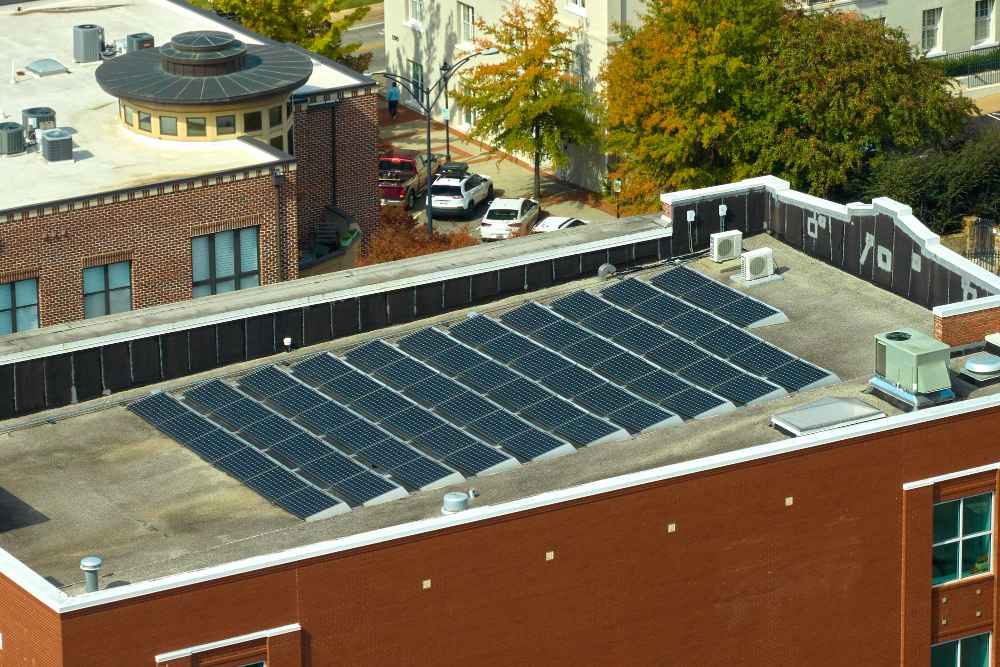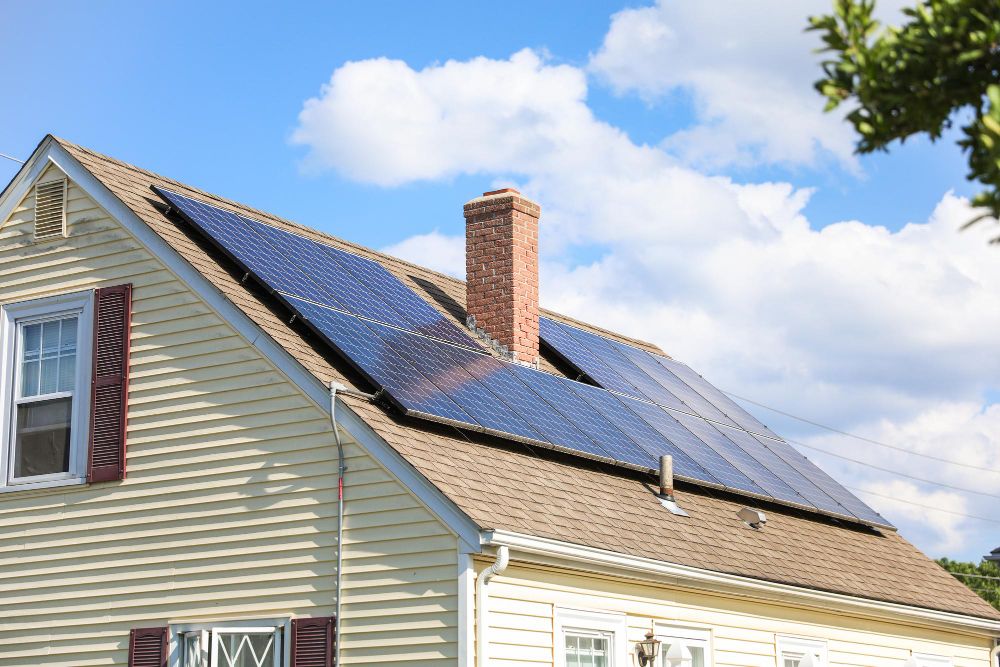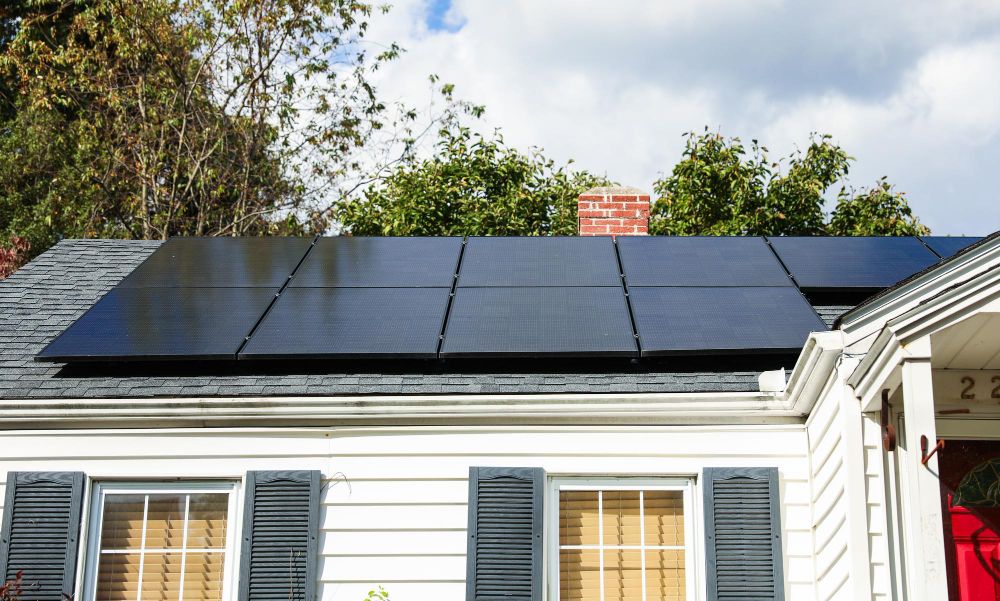Can You Put Solar Panels on a Flat Roof?
Table of Contents

Installing Solar Panels on Flat Roofs: What You Need to Know
Installing solar panels on flat roofs has become an increasingly popular option for both residential and commercial properties as the demand for renewable energy surges. This innovative approach not only maximises energy efficiency but also transforms unused roof space into a powerful energy-generating system. However, before leaping into solar, there are several important factors to consider, including the structural integrity of the roof, possible installation techniques, and local regulations. This blog post will cover everything you need to know to make an informed decision about harnessing the sun’s energy through solar panels on flat roofs.
Can Solar Panels Be Installed on a Flat Roof?
Yes, solar panels can be installed on flat roofs, and this practice is common, especially for commercial buildings and some residential homes. Flat roofs have minimal slope, making them suitable for solar photovoltaic (PV) systems. A roof with a slope of 0.25 inches over a 12-inch span—termed a 0.25:12 pitch roof—is classified as flat. These roofs are often referred to as low-pitched roofs.
While challenges exist with flat roofs, solutions are available to adapt solar systems to various roof types. Flat roofs provide a large, unobstructed area for solar installations, and the panels can be mounted using specialised mounting systems. Though flat roofs are not ideal for energy production, they can be optimised with appropriate tools and techniques.
When installing on flat roofs, it is crucial to leave enough space between the rows of panels to facilitate maintenance and prevent shading from adjacent panels. Additionally, these installations may require extra space for proper ventilation and to reduce shading from nearby panels.
Challenges of Installing Solar Panels on Flat Roofs
Solar panels are a popular choice for people looking to cut down on their carbon footprint and save on energy bills. While they are generally easy to install on sloped roofs, putting them on flat roofs can be trickier:
Weather Issues: Weather is an important factor for flat roofs. Heavy rain can cause water to pool, damaging the panels. This can be fixed with a mounting rack. However, strong winds are a bigger concern. In windy regions, securing the panels properly is crucial. Common methods include anchoring them to the house or adding weights on top.
Location: Make sure your flat roof is in a good spot for solar panels. Check that nearby buildings or trees don’t block sunlight.
Structural Strength: The flat roof must be strong enough to support the weight of the solar panels and resist wind. Since flat roofs aren’t usually built to carry heavy loads, you might need additional support for your solar panels.
Maintenance: Flat roofs require more care than sloped roofs because they can collect water after heavy rain or snow. Good drainage solutions are essential when installing solar panels to avoid issues.
Mounting System: To securely mount solar panels on a flat roof, you need a suitable system that keeps them stable. This prevents the panels from moving or becoming loose over time, which is important since they work best at a 30-degree angle in UK homes.
Steps to Install Solar Panels on a Flat Roof
In contrast to pitched roofs, flat roofs lack the natural slope necessary for solar panels to harness sunlight efficiently. To address this issue, the panels must be installed at an angle using different methods, such as frames, concrete, or ballasts. The best option depends on your roof’s size and its capacity to hold extra weight. Follow these important steps when installing solar panels on a flat roof:
Prepare and Plan
Engineers will check if your roof can hold solar panels and additional weight and determine the roof’s condition and structure. You may need a structural engineer to inspect it. Your installer will also look for shading issues from nearby buildings or trees and evaluate your energy needs to determine the number and size of panels you’ll require.
Obtain Permits
The installer will handle obtaining any necessary permits from local authorities and utility providers, guiding you on applicable laws and regulations.
Design the System
Experts will determine how many panels you need based on your energy use and roof space. They will choose the best layout, tilt, and orientation for the solar panel system to improve sunlight exposure and assess if you need a grid-tied, off-grid, or hybrid system.
Choose Components
Next, purchase essential parts, starting with solar panels that meet your design and energy needs. You’ll also need an inverter, micro inverters, or power optimisers. Choose high-quality components to ensure your solar power system lasts and works efficiently. Additionally, you’ll need mounting brackets, rails, ballast mounts for flat roofs, and all necessary cables and conduits.
Prepare the Roof and Layout
The installer will remove dirt, debris, and obstructions from the roof, check for damage, and make necessary repairs. Safety equipment, like harnesses and helmets, should be used during installation for protection. Mark where to place the mounting racks, ensuring they are spaced appropriately. Place the ballast trays or racks without making any punctures.
Attach Rails to Mounts
Fasten the mounting rails to the ballast trays or mounts securely, checking that they are level and aligned.
Install Solar Panels
Attach the solar panels to the mounting rails with clamps or brackets, leaving a small gap between them for thermal expansion and ventilation. Connect the electrical components and wiring from the panels to the inverter according to the manufacturer’s instructions.
Inverter and Electrical Setup
Install the inverter near the main electrical panel for easier connections. Connect the solar array to the inverter and wire it to the main panel, where you’ll install a solar breaker. Make sure the system complies with local electrical codes and safety standards.
Testing and Commissioning
Conduct a thorough inspection to ensure all connections are secure and the installation is correct. Test the system to confirm it generates electricity as expected and undertake monitoring to track performance and identify any issues.
Maintenance
Inspect the panels and mounting system regularly for wear and tear. Clean the panels to maintain efficiency and schedule an annual check with your installer to keep the system operating well.


The Working Phenomenon of Solar Panels on a Flat Roof
Solar panels mounted on flat roofs convert sunlight into electricity in much the same way as those on sloped roofs. To enhance efficiency, they are often installed at an angle using specialised frames or ballasts, optimising light exposure and promoting self-cleaning. This angled setup allows for better sunlight capture and reduces debris accumulation on the panels.
Photovoltaic Effect
Solar panels utilise photovoltaic cells (PV cells) that transform sunlight (photons) straight into electricity (voltage), a phenomenon known as the photovoltaic effect.
Angle Optimisation
Solar panels on flat roofs are typically not installed horizontally; instead, they are positioned at an angle ranging from 10 to 50 degrees to optimise sunlight capture. This slanted setup also allows rainwater to wash away dirt and debris, ensuring efficient panel performance.
Mounting Systems
Various mounting systems, such as tilted frames, ballasted mounts (where panels are weighted to prevent wind movement), or roof-penetrating systems, can be installed on flat roofs.
Wind Resistance
On flat roofs, which often experience higher wind exposure, ballasted mounts are frequently employed to secure the solar panels in place.
Orientation and Shading
To achieve the best energy production, flat roof solar panels should face South in the UK and are positioned strategically to reduce shading from surrounding objects.
Self-Cleaning
An appropriate angle can facilitate the natural cleaning of panels during rain, much like sloped roofs; however, flat panels may need more regular cleaning, particularly if not sufficiently angled.
Framing System
Solar panels on flat roofs are similar to those on pitched roofs, but installing them flat can reduce sun exposure and lead to water damage. To optimise sun absorption, it’s important to tilt the panels. There are two main ways to secure solar panels on flat roofs:
Securing Panels to the Roof: This involves drilling into the roof to attach brackets, ensuring the panels are stable without compromising the roof’s waterproof seal.
Adding Weight: If you can’t drill into the roof, another option is to use weight. The mounting frame can rest on heavy concrete slabs for better wind resistance, or panels can be anchored to special tubs filled with heavy materials.
Is Planning Permission Needed for Installing Solar Panels on Flat Roofs?
In 2023, the UK Government streamlined the process for homeowners to install solar panels on flat roofs by eliminating the requirement of planning permission. Now, in the UK, these installations usually don’t require special approval.
Securing planning permission for flat roofs is like that for pitched roofs. Consent isn’t needed if your installer follows local council guidelines. However, it’s a good idea to check with your Local Planning Authority before starting any work to ensure you follow the rules.
Your solar panel system must meet certain general conditions:
- It should be installed to keep the building’s look and surroundings pleasing.
- It cannot stick out more than 0.2 meters from the roof.
- It shouldn’t be taller than the highest point of the roof, except for the chimney.
- If the solar panels are no longer needed, they should be removed as soon as possible.
Pros & Cons of Installing Solar Panels on a Flat Roof
Installing solar panels on a flat roof offers distinct advantages and disadvantages, requiring additional considerations.
Pros of Installing Flat Roof Solar Panels
Simple Installation and Upkeep: Solar panels installed on flat roofs offer easier maintenance access, rendering them safer compared to those situated on sloped roofs.
Subtle Appearance: Flat roofs minimise concerns about how solar panels look, so neighbours and passersby may not even notice them.
Adjustable Mountings: The ballasts for flat roof solar systems can be easily changed, allowing you to adjust the angle of the panels for better efficiency.
Significant Savings on Bills: Installing solar panels can cut a household’s electricity bill by up to 70%, saving between £272 and £636 per year.
Lower Carbon Footprint: A typical solar system can reduce your carbon emissions by about one tonne each year, depending on where you live.
Low Maintenance: To maintain your solar panels, you mainly need to keep them clean, which typically only requires cleaning twice a year.
Lower Labour Costs: Installers can easily access flat roofs, often removing the need for scaffolding. Installing on flat roofs is usually quicker and cheaper, leading to lower labour costs per kW.
Cons of Installing Flat Roof Solar Panels
While flat roof solar panels have some drawbacks, many can be overcome with a tilted mounting system.
Increased Dirt Accumulation: On tilted roofs, rainwater washes away dirt and debris, helping to keep the panels clean and efficiently performing. In contrast, flat roofs tend to collect debris, which can reduce the effectiveness of the solar panels.
Higher Installation Costs: The added cost of mounting stands and ballasts can make installation more expensive.
Needs Mounting Equipment: Solar panels installed on flat roofs receive less sunlight, lowering their conversion efficiency. Therefore, solar panels are usually oriented South on flat roofs to optimise sun exposure and energy output by mounting them on specialised equipment.
Compromised Warranties: Flat installations can trap water between the frame and the glass coating, which is only sealed with silicone that can wear out over time. This can result in faster damage to the panels and negatively impact their warranties.
Increased Wind Impact: Wind affects flat installations more, requiring careful planning from your installer. Sometimes, additional ballast weight is needed, which might require a structural engineer to ensure the roof can support the extra load.
Conclusion
Installing solar panels on flat roofs presents a unique opportunity to harness solar energy efficiently. While there are several factors to consider, including the type of mounting system, drainage requirements, and local regulations, the benefits often outweigh the challenges. Proper installation can lead to enhanced energy efficiency and lower utility costs. Furthermore, with the increasing advances in solar technology and incentives for renewable energy, it is now an opportune time to consider flat roof solar panel installations. With careful planning and execution, homeowners and businesses alike can contribute to a more sustainable future while enjoying the advantages of clean energy.
